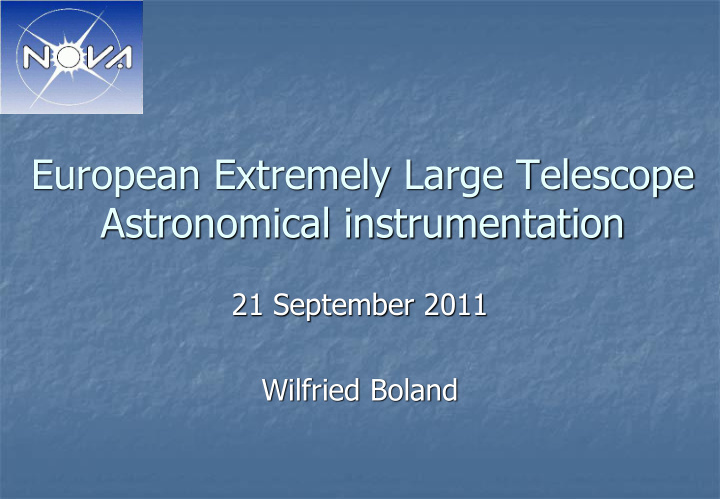



European Extremely Large Telescope Astronomical instrumentation 21 September 2011 Wilfried Boland
NOVA introduction Netherlands Research School for Astronomy Top research school, evaluated exemplary in 2010 Federation of university astronomy institutes 290 fte scientific staff (20% is directly funded by NOVA) Mission Facilitating top astronomical research in the Netherlands Hire researchers Build instruments Train young astronomers at highest international level 2
ESO Very Large Telescope
Atacama Large Millimeter Array ALMA
NOVA ESO projecten X-Shooter nabij-IR OmegaCAM voor VST → MIDI spectroscopische NEVEC OmegaCEN arm MUSE-ASSIST: test set-up SINFONI: 2k camera voor SPIFFI: voor nieuwe VLT Optical bench voor nabij-IR integral field spectrometer deformeerbare secundaire SPHERE Zimpol spiegel
European Extremely Large Telecope Nieuwe grote ESO project: ~40m optisch/IR telescoop Fase B afgerond: klaar voor de bouw! (na goedkeuring Council)
NOVA instrumentation program Many discoveries are driven by new instrument capabilities Involvement in instrument decision about functionality Involvement in instrument understanding the instrument performance Involvement in instrument early access to data Involvement in instrument ideal position to make discoveries! NOVA strategy: Design & construct instruments for international facilities Focus on ESO NOVA Optical-Infrared instrumentation group located at ASTRON in Dwingeloo 10
Instrument Project Characteristics Collaborations with international partners (for ESO projects ~4-6 partners) NOVA astronomer NL-leader and connection to the international consortium Common Project management procedures under ESO protocol (PDR, FDR, progress meetings etc.) Hardware design and manufacturing by NOVA Optical- IR instrumentation group Dutch astronomers in (inter)national science team to ensure interesting capabilities 11
NOVA and the E-ELT Objective: Participate in design & construction of instrumentation for E-ELT In one as a leading partner (40% share) In another one as minor partner (20% share) Funding: General NOVA budget ESFRI grant of 18.78 M € 8.78M € for design and development 10M € to build one instrument (requires PI role) Other grants 12
E-ELT: 8 SCIENCE INSTRUMENTS +2 Post Focal AO MODULE STUDIES INSTRUMENT MAIN OBSERVING MODES . OPTIMOS Multi-slit and fiber MOS options are being studied CODEX High Resolution, High Stability Visual Spectrograph METIS Mid IR camera /spectrograph EAGLE WF, Multi IFU NIR Spectrograph. +AO HARMONI Single IFU , Wide Spectral Band Spectrograph SIMPLE High-Resolution IR spectrograph MICADO NIR Camera sampling to the DF EPICS + XAO Planet Imager and Spectrograph MAORY (MCAO) with 2 additional DM LTAO Module Provides DL images over a field <30” 13 Slide 13 Sensor Universe 25-11-2010
E-ELT Instrumentation in NL Consortium: Universities: NOVA, TU Delft, UTwente Technological institutes: ASTRON, SRON & TNO Companies: Airborne Composite BV, Dutch Space, JPE Applied for in 2008, awarded in 2009, end 2020+ Phase I (8.78M € ): Preliminary design (4 instruments) Technology developments Phase II (10M € ): Construction of one instrument 14
Industrial participation Large research facilities means big business Industry can become project supplier to ESO and/or NOVA Construction of the telescope Delivery of subsystems to the telescope Supplier of parts of instrumentation, or partner in (optical, mechanical or thermal) design; partner is R&D to demonstrate technical readiness 15
Industrial participation Large research facilities means big business Industry can become project supplier to ESO and/or NOVA Construction of the telescope Delivery of subsystems to the telescope Supplier of parts of instrumentation, or partner in (optical, mechanical or thermal) design; partner is R&D to demonstrate technical readiness 16
Technology developments I Vibration-free and precise cryo-coolers Present partners: UTwente, Dutch Space Motivation: High precision instruments, no vibrations Potential solution: sorption coolers Remaining problems: Cooling power too low (10mW 1W) University product commercial product 17
Technology developments II Movable cryogenic systems Present partners: NOVA Op-IR, JPE, SRON, TNO Motivation: High precision positioning and stability of movable elements in a cryogenic environment (80K) Problems: Opto-mechanical engineering Very accurate positioning (nm), metrology and control 18
Technology developments III New optical components and materials Present partners: Airborne, NOVA Op-IR, SRON, TNO Motivation: Standard techniques will make the instrument rather big and heavy, or do not provide the required stability Potential solutions: composite materials, immersed gratings, integrated optics, smart optics, free form mirrors Remaining problems: Behavior of composite materials in a cryo-vacuum environment (stiffness, air tightness, out-gassing) Immersed gratings have not yet been made with the required accuracy Manufacture products with the required accuracy (required micro-roughness RMS for free-form 30cm large Al mirrors = 15nm) 19
Technology developments IV Other areas where NOVA will look for partners: Polarimetric elements and engineering Precision engineering Better performance prediction, improved overall system engineering control, modeling alignment tolerances, Advanced data flow system AO Control (hardware and software) Industrial production process There are many opportunities for industrial participation and products! 20
One example: METIS Mid-infrared E-ELT Imager and Spectrograph Operating from 3 to 14 micron Imager (L,M, N-band) Low resolution long slit spectrometer (L, M, N-band) High resolution IFU spectrometer (L, M band) Coronography (L, M, N band) Polarimetry (N-band) NOVA has PI role Overall project management High resolution IFU spectrograph Fore optics Cold central structure 21
Conclusion and Contact There are many opportunities for industrial participation and products! Wilfried Boland (boland@strw.leidenuniv.nl) Frank Molster (molster@strw.leidenuniv.nl)
Recommend
More recommend